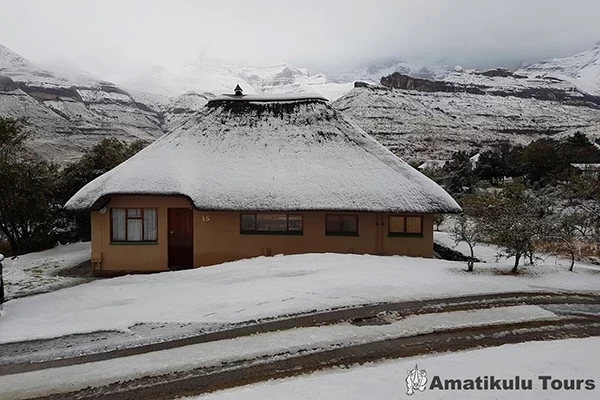
The Majestic Drakensberg Mountain Range
The Drakensberg: A Majestic Landscape of Nature and Culture
When we speak of the Drakensberg, we’re not merely referring to a mountain range; we’re invoking the spirit of the "Dragon's Mountain," as its Afrikaans name suggests. This Southern African marvel stretches over a thousand kilometers (600 miles), carving a path from South Africa’s Eastern Cape through KwaZulu-Natal and into Lesotho. It forms part of the Great Escarpment’s eastern edge, a geological wonder imbued with dramatic landscapes, unparalleled biodiversity, and a deeply rooted cultural heritage.
Awe-Inspiring Geography
Soaring to a breathtaking 3,482 meters (11,423 feet) at its zenith, Thabana Ntlenyana stands as the king of the Drakensberg. Here, the range reveals itself through towering basaltic cliffs, plunging valleys, and sprawling high plateaus. The skies above frequently unleash rains, feeding countless rivers and waterfalls that cascade down into verdant slopes, where life thrives in every crevice. This isn’t just a mountain range; it’s an ecological masterpiece sculpted by time.
A Sanctuary of Life
The Drakensberg is more than rock and stone—it’s a pulsating heart of biodiversity. This region harbours life forms that exist nowhere else on Earth. Ukhahlamba-Drakensberg Park, a UNESCO World Heritage Site, serves as a sanctuary for this astonishing diversity. From grasslands to forests, each habitat offers a new array of flora and fauna, ensuring that the mountain range teems with life and vibrancy.
Floral Splendor
With over 2,153 recorded plant species, the Drakensberg is a garden in the clouds. Each level offers a different floral wonder, from the lower slopes adorned in grasslands to the high-altitude montane forests and heathlands. Come spring and summer, wildflowers like the Drakensberg daisies and proteas explode in a riot of colour, a testament to nature's artistry.
Faunal Richness
In the grassy plains, eland, reedbuck, and the elusive oribi roam freely, while high above, the cliffs become homes to majestic birds of prey. Here, the endangered Bearded Vulture and the Cape Vulture take to the skies, a sight that stirs the soul of anyone lucky enough to witness it. And yet, the magic of the Drakensberg doesn’t end there—its hidden inhabitants, such as the Drakensberg frog and crag lizard, remind us of the ancient and delicate balance of life sustained in this mountain sanctuary.
Echoes of the Past: Cultural Significance
But the Drakensberg is not just a biological gem but also a cradle of human history. The San people, with their history spanning millennia, have etched their legacy into the very rocks through intricate art. Over 4,000 years of human expression are captured in the rock art of this region, making the Drakensberg one of the most significant repositories of ancient human creativity.
The Legacy of San Rock Art
More than 35,000 individual paintings, spread across 600 rock art sites, offer glimpses into the world of the San. These artworks—depictions of hunts, spiritual rituals, and daily life—are not just images but portals to a time when humans lived in profound harmony with nature. Each brushstroke tells a story of reverence for the land and the creatures they shared it with.
Zulu and Sotho Heritage
And it’s not just the San who hold the Drakensberg in high esteem. With their rich oral traditions, the Zulu and Sotho peoples also draw cultural strength from these mountains. For the Zulu, in particular, the Drakensberg is sacred, where ancient ceremonies echo through the valleys, carried by the wind that sweeps across the peaks.
Adventure Awaits: Tourism and Recreation
For modern-day explorers, the Drakensberg offers more than spiritual reflection; it’s a playground of rugged beauty that attracts adventurers from all walks of life.
Hiking: Trails of Wonder
The vast network of trails winds through the range, offering leisurely strolls to gruelling multi-day treks. The Amphitheatre, one of the most iconic cliffs, beckons hikers with its dramatic vistas. Those who reach its summit are rewarded with views so stunning that they seem almost otherworldly.
Scaling the Heights: Rock Climbing and Mountaineering
The jagged cliffs and towering peaks aren’t just for looking but for climbing. Sentinel Peak and Cathedral Peak challenge even the most experienced mountaineers, while the range’s other routes provide thrills for all levels of climbing enthusiasts.
Wildlife and Birdwatching: Nature’s Showcase
Birdwatchers and wildlife enthusiasts find themselves in paradise here. From the abundant wildlife grazing on the slopes to the rare sight of the endangered Bearded Vulture, the Drakensberg is a testament to the wonders of the natural world.
The Struggles of Preservation: Conservation Challenges
But even as we marvel at the Drakensberg, its future is uncertain. The range faces increasing threats from habitat destruction, climate change, and invasive species.
Habitat Loss
Human encroachment through agriculture, urbanization, and development continues to fragment habitats, endangering the survival of native species. Once lost, these delicate ecosystems may never recover.
Climate’s Changing Face
As the planet warms, the Drakensberg’s rainfall patterns and temperatures shift. These changes disrupt the balance of life, altering everything from blooming cycles to migration patterns, putting the region’s unique biodiversity at risk.
Invasive Species
Non-native plants like the black wattle and bramble creep into the landscape, overwhelming indigenous species and reshaping the ecosystem's foundation. Conservation efforts must be redoubled to combat this silent invasion.
Conclusion: A Treasure to Protect
The Drakensberg stands tall as a symbol of natural grandeur and cultural depth. From its towering peaks to its colourful valleys, ancient rock art, and endangered vultures, this mountain range offers a connection to both the past and the future. But as we explore and enjoy its wonders, we must remain vigilant stewards, ensuring that the Drakensberg’s beauty endures for generations yet to come.
